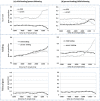Joint attention without gaze following: human infants and their parents coordinate visual attention to objects through eye-hand coordination
- PMID: 24236151
- PMCID: PMC3827436
- DOI: 10.1371/journal.pone.0079659
Joint attention without gaze following: human infants and their parents coordinate visual attention to objects through eye-hand coordination
Abstract
The coordination of visual attention among social partners is central to many components of human behavior and human development. Previous research has focused on one pathway to the coordination of looking behavior by social partners, gaze following. The extant evidence shows that even very young infants follow the direction of another's gaze but they do so only in highly constrained spatial contexts because gaze direction is not a spatially precise cue as to the visual target and not easily used in spatially complex social interactions. Our findings, derived from the moment-to-moment tracking of eye gaze of one-year-olds and their parents as they actively played with toys, provide evidence for an alternative pathway, through the coordination of hands and eyes in goal-directed action. In goal-directed actions, the hands and eyes of the actor are tightly coordinated both temporally and spatially, and thus, in contexts including manual engagement with objects, hand movements and eye movements provide redundant information about where the eyes are looking. Our findings show that one-year-olds rarely look to the parent's face and eyes in these contexts but rather infants and parents coordinate looking behavior without gaze following by attending to objects held by the self or the social partner. This pathway, through eye-hand coupling, leads to coordinated joint switches in visual attention and to an overall high rate of looking at the same object at the same time, and may be the dominant pathway through which physically active toddlers align their looking behavior with a social partner.
Conflict of interest statement
Figures






Similar articles
-
Linking Joint Attention with Hand-Eye Coordination - A Sensorimotor Approach to Understanding Child-Parent Social Interaction.Cogsci. 2015 Jul;2015:2763-2768. Cogsci. 2015. PMID: 29226280 Free PMC article.
-
Hand-Eye Coordination Predicts Joint Attention.Child Dev. 2017 Nov;88(6):2060-2078. doi: 10.1111/cdev.12730. Epub 2017 Feb 10. Child Dev. 2017. PMID: 28186339 Free PMC article.
-
Watch the hands: infants can learn to follow gaze by seeing adults manipulate objects.Dev Sci. 2014 Mar;17(2):270-81. doi: 10.1111/desc.12122. Epub 2014 Jan 4. Dev Sci. 2014. PMID: 24387193
-
Visual attention and action: How cueing, direct mapping, and social interactions drive orienting.Psychon Bull Rev. 2018 Oct;25(5):1585-1605. doi: 10.3758/s13423-017-1354-0. Psychon Bull Rev. 2018. PMID: 28808932 Review.
-
From gaze cueing to dual eye-tracking: novel approaches to investigate the neural correlates of gaze in social interaction.Neurosci Biobehav Rev. 2013 Dec;37(10 Pt 2):2516-28. doi: 10.1016/j.neubiorev.2013.07.017. Epub 2013 Aug 5. Neurosci Biobehav Rev. 2013. PMID: 23928088 Review.
Cited by
-
Exposure to unpredictability and mental health: Validation of the brief version of the Questionnaire of Unpredictability in Childhood (QUIC-5) in English and Spanish.Front Psychol. 2022 Nov 9;13:971350. doi: 10.3389/fpsyg.2022.971350. eCollection 2022. Front Psychol. 2022. PMID: 36438371 Free PMC article.
-
Contributions of head-mounted cameras to studying the visual environments of infants and young children.J Cogn Dev. 2015;16(3):407-419. doi: 10.1080/15248372.2014.933430. J Cogn Dev. 2015. PMID: 26257584 Free PMC article.
-
When do toddlers point during mealtime?: Pointing in the second year of life in everyday situations.Front Psychol. 2023 Jan 26;14:1050975. doi: 10.3389/fpsyg.2023.1050975. eCollection 2023. Front Psychol. 2023. PMID: 36777198 Free PMC article.
-
Visual-motor coordination in natural reaching of young children and adults.Cogsci. 2015 Jul;2015:728-733. Cogsci. 2015. PMID: 29226279 Free PMC article.
-
What does it take to learn a word?Wiley Interdiscip Rev Cogn Sci. 2017 Jan;8(1-2):10.1002/wcs.1421. doi: 10.1002/wcs.1421. Epub 2016 Dec 1. Wiley Interdiscip Rev Cogn Sci. 2017. PMID: 27911490 Free PMC article. Review.
References
-
- Sebanz N, Knoblich G (2009) Prediction in joint action: What, when, and where. Topics in Cognitive Science 1: 353–367. - PubMed
-
- Kraut RE, Fussell SR, Siegel J (2003) Visual information as a conversational resource in collaborative physical tasks. Human-computer interaction 18: 13–49.
-
- Clark HH, Krych MA (2004) Speaking while monitoring addressees for understanding. Journal of Memory and Language 50: 62–81.
-
- Garrod S, Pickering MJ (2007) Alignment in dialogue. The Oxford handbook of psycholinguistics: 443–451.
Publication types
MeSH terms
Grants and funding
LinkOut - more resources
Full Text Sources
Other Literature Sources
Medical

